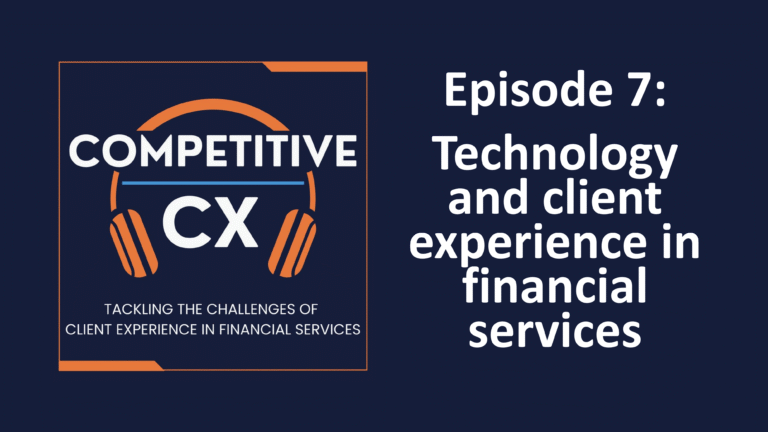In brief
Technology and client experience in financial services can sometimes be at odds – but they don’t have to be. In this episode of Competitive CX, Aimer, Taylor, and Grainger explain how misapplied tech creates friction and frustration, while well-designed solutions amplify human value and build trust. You’ll learn why CX leaders must translate between business, client, and technology – and how to design from the client outward, not the system inward.
Is technology an enabler or disabler for CX?
In Episode 7 of Competitive CX, Melanie Aimer, Hamish Taylor, and Adam Grainger tackle the relationship between technology and client experience in financial services. While tech promises speed, scale, and efficiency, it can also deliver friction, confusion, and depersonalisation – especially in financial services.
This episode, therefore, explores how to close the gap between internal efficiency and actual client impact.
“We can focus so much on internal efficiency, that we forget clients don’t feel efficiency – they feel clarity, responsiveness, forethought.”
Adam Grainger
The hosts challenge firms to stop measuring success by process automation alone and start designing tech experiences that serve real client needs. From AI’s growing influence to the enduring power of human touch, this episode makes one thing clear: technology is not the problem. Misapplied technology is.
Technology and client experience in financial services
In this episode of Competitive CX, the team asks whether technology in financial services is an enabler or disabler of client experience.
Grainger challenges the blind assumption that tech equals improved client experience, arguing that firms often optimise for internal cost savings while clients feel no benefit. He advocates a mindset shift: “from technology as a shortcut, to technology as an amplifier.”
“AI is a huge enabler and a huge leveller for client experience that can be either an opportunity or a threat, depending on how you respond.”
Adam Grainger
Taylor warns against letting efficiency KPIs dictate transformation, saying CX professionals must “shout from the rooftops” when tech harms the client. He urges firms to balance automation with advocacy.
“If a tech initiative is going to harm the client experience, it’s your duty to shout from the rooftops. If you don’t fight for the customer, who will?”
Hamish Taylor
Aimer stresses the value of improving digital CX in finance without losing the human touch: not every client wants digital-first. High-value clients, or those less digitally fluent, may still crave human reassurance.
“For some clients, fast self-service is a relief. For others, the reassurance of a real conversation is essential.”
Melanie Aimer
Together, they call for smarter combinations of AI and human interaction in CX – not to replace human connection with AI, but to enhance it – and for CX leaders to act as translators between business, tech, and the client.
Key Takeaways
- Tech should amplify human interactions, not just replace them.
- Internal efficiency gains mean little if clients feel no benefit.
- CX professionals must be the client’s voice during digital transformation.
- AI in finance must be guided, not left unsupervised.
- Segment your tech strategy: not every client wants the same kind of service.
- Make client satisfaction an explicit KPI in every tech rollout.
- Design from the client’s perspective first, then implement technology.
If you’re an asset manager, check out Accomplish’s client experience services here.
And if you just found this useful, check out our other podcast episodes designed for financial services professionals:
- Why care about CX?
- What is CX and who should own it?
- Cultures that kick CX down the road.
- Organisational structure gets in the way of CX.
- Incentives that inadvertently deprioritise CX.
- Regulator – friend or foe to CX?
- Technology – enabler or disabler for CX?
- Solving the most common CX complaints.
- Where to start with CX?
Listen to the full recordings on Podbean.
Connect with Hamish Taylor, Melanie Aimer and Adam Grainger on LinkedIn and follow Competitive CX for cutting-edge insights on client experience in finance.
Frequently asked questions
1. How does technology affect client experience in financial services?
Technology can enhance and diminish client experience. When applied with a client-first mindset, it enables clarity, responsiveness, and personalisation – but if misaligned, it can cause confusion, delays, and depersonalisation.
2. Why do internal efficiency metrics often conflict with CX goals?
Efficiency KPIs typically measure speed and cost savings, not client satisfaction. As a result, firms may optimise processes that serve the business, while the client may feel neglected or frustrated.
3. Can AI improve client experience in finance?
Yes – but only when guided by clear intent and client insight. AI should be used to support human interaction, not replace it, and must be continuously monitored to avoid unintended harm.
4. What’s the best way to balance technology and human touch in CX?
Segment your clients by needs and preferences. Some will value self-service and speed; others – especially high-value or less tech-savvy clients – may require human reassurance to build trust and loyalty.








